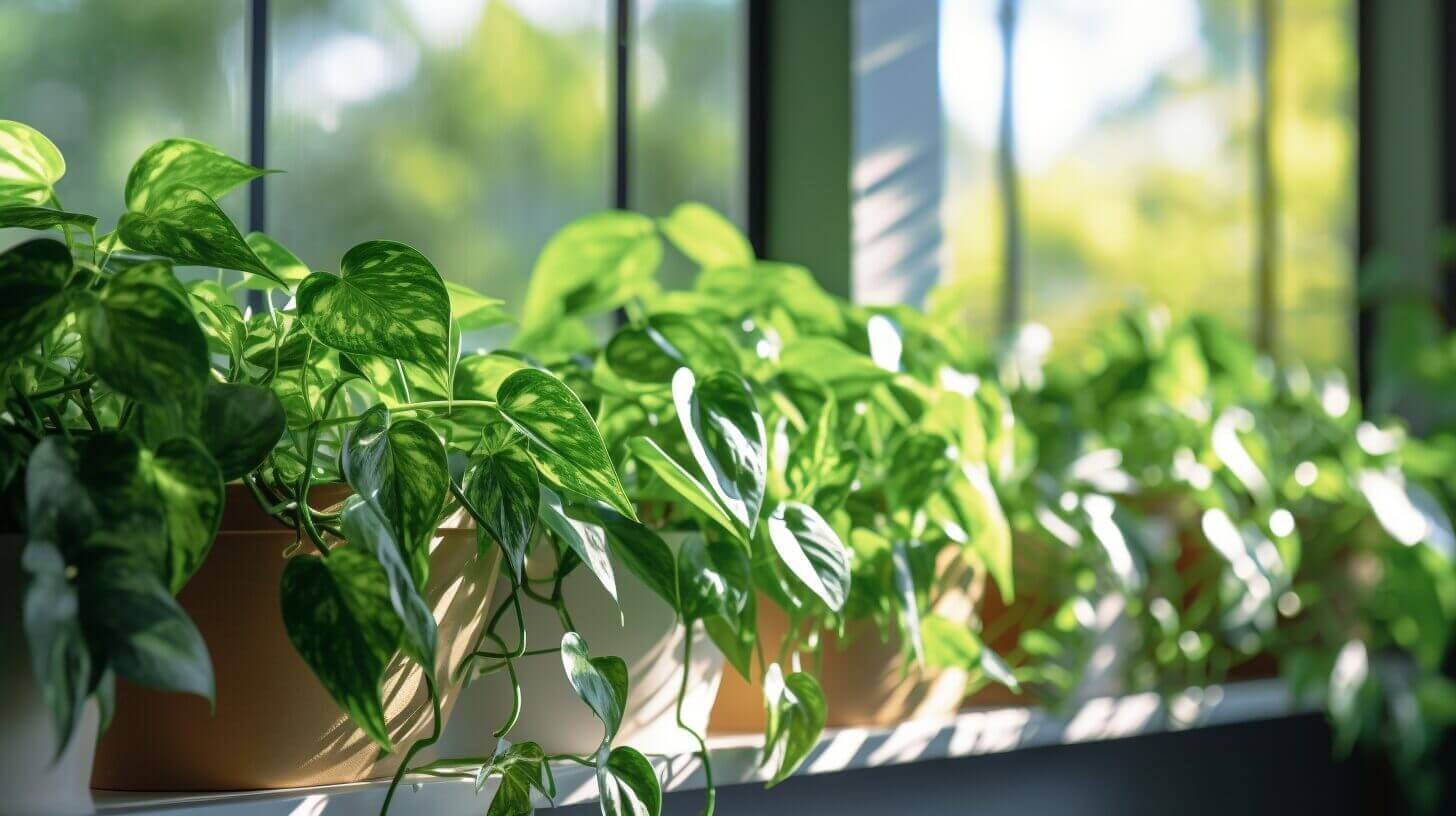Why You May Need to Repot Pothos Plant: A Quick Plant Care Guide
In the world of horticulture, plants have the remarkable ability to symbolize growth, renewal, and the beauty of nature. Among these, the pothos plant stands out, captivating hearts with its lush green leaves and trailing vines.
However, as with any living organism, the pothos plant requires care and attention to thrive. In this quick guide, we will explore when and how to repot your pothos plant, ensuring its continued vitality and fostering a sense of belonging within your botanical haven.
Key Takeaways
- Signs that indicate the need for repotting include roots growing out of drainage holes, stunted growth, yellowing leaves, and decline in overall health.
- When repotting a pothos plant, choose a pot that is one size larger than the current pot, with drainage holes, and made of breathable material like clay or terracotta.
- Use high-quality well-draining potting soil for repotting and avoid using garden soil.
- After repotting, water the pothos plant when the top inch of soil is dry, provide bright indirect light, increase humidity, and fertilize regularly during the growing season. Avoid direct sunlight.
Signs That Your Pothos Houseplant Needs Repotting
One of the signs that you, as a plant owner, should look out for to determine if your pothos plant needs repotting is if the roots are starting to grow out of the drainage holes in the current pot. This is a clear indication that your plant has become root bound, meaning that the roots have outgrown the available space in the pot and are in need of more room to grow.
Root bound symptoms can include stunted growth, yellowing leaves, and a general decline in the plant’s overall health. If you notice any of these signs, it is important to take action and repot your pothos plant as soon as possible to ensure its continued well-being.
The frequency at which you should repot your pothos plant depends on its growth rate. Typically, it is recommended to repot every 1-2 years. However, if your plant is growing rapidly and showing signs of being root bound sooner, it may need to be repotted more frequently.
To repot your pothos plant, start by selecting a pot that is one size larger than the current one. Gently remove the plant from its current pot, being careful not to damage the roots. Loosen the root ball and place it in the new pot, adding fresh potting soil around the roots. Water the plant thoroughly and place it in a location with bright, indirect light.
Choosing New Pot and Soil for Repotting
Selecting the appropriate pot size and using a high-quality potting soil are crucial factors in ensuring successful repotting of your pothos plant. When it comes to repotting your pothos, it is important to choose the right pot and soil to provide the best conditions for its growth and development.
Here’s how to determine the ideal pot size for your pothos:
- Consider the current size of your pothos plant. A good rule of thumb is to choose a pot that is one size larger than its current one. This allows room for the roots to spread and grow.
- Look for a pot that has drainage holes at the bottom. Proper drainage is essential to prevent overwatering and root rot.
- Opt for a pot made of a breathable material such as clay or terracotta. These materials allow for better airflow to the roots.
- Choose a high-quality potting soil that is well-draining and nutrient-rich. Avoid using garden soil, as it may contain pests or diseases that can harm your plant.
Step-by-Step Guide to Repotting Your Pothos Plant
To successfully repot your pothos plant, it is essential to carefully follow each step in the step-by-step guide, ensuring that you provide your plant with the optimal conditions for healthy growth and development.
The first step is to choose the right pot size. Pothos plants prefer to have a little room to grow, so it is recommended to select a pot that is one size larger than its current one. This will allow the roots to have enough space to expand and prevent the plant from becoming root-bound.
Next, consider the repotting frequency. Pothos plants generally need to be repotted every 1-2 years, or when the roots start to outgrow the pot. Signs that your plant may need repotting include dried-out soil, stunted growth, or roots coming out of the drainage holes.
When repotting, gently remove the plant from its current pot, being careful not to damage the roots. Shake off any excess soil and inspect the roots for any signs of rot or disease. Trim off any dead or damaged roots using clean shears.
Finally, place the pothos plant in its new pot, filling it with fresh potting soil. Make sure to firmly press the soil around the roots to provide stability. Water the plant thoroughly, allowing the excess water to drain out. Place the newly repotted pothos in a bright, indirect light location, and continue to care for it as usual.
Caring for Your Repotted Pothos: Watering and Light Requirements
In order to properly care for your repotted pothos, it is crucial to diligently adhere to the appropriate watering and light requirements, ensuring optimal conditions for the plant’s well-being and growth. Here are some key points to consider:
- Watering frequency: Pothos plants prefer slightly moist soil, so it is important to water them when the top inch of soil feels dry to the touch. Overwatering can lead to root rot, while underwatering can cause the leaves to wilt and turn yellow.
- Optimal light conditions: Pothos plants thrive in bright, indirect light. They can tolerate low light conditions, but their growth may slow down. Avoid placing them in direct sunlight as it can scorch their leaves.
- Provide humidity: Pothos plants appreciate higher humidity levels. You can increase humidity by placing a tray filled with water near the plant or by misting the leaves regularly.
- Fertilize regularly: Pothos plants benefit from regular fertilization during the growing season. Use a balanced, water-soluble fertilizer and follow the instructions on the packaging.
By following these guidelines, you can create an environment that promotes the health and growth of your repotted pothos.
However, if you encounter any issues, such as yellowing leaves or wilting, don’t worry. In the next section, we will discuss troubleshooting common issues after repotting your pothos.
Troubleshooting Common Issues After Repotting Your Pothos
After repotting your pothos, if you notice any signs of wilting or yellowing leaves, it is important to address these issues promptly in order to ensure the plant’s successful adaptation to its new environment. These common issues can often be attributed to mistakes made during the repotting process or inadequate care after repotting. One of the most common mistakes is overwatering, which can lead to root rot. To prevent root rot and promote healthy growth, it is essential to understand the proper watering techniques for your pothos.
Here are some steps to prevent root rot and troubleshoot common issues after repotting your pothos:
| Issue | Possible Cause | Solution |
|---|---|---|
| Wilting leaves | Underwatering | Ensure the soil is evenly moist and water the plant when the top inch of soil feels dry. |
| Yellowing leaves | Overwatering | Allow the soil to dry out slightly between waterings and ensure proper drainage. |
| Root rot | Overwatering | Remove the plant from the pot, trim off any affected roots, and repot in well-draining soil. |
Frequently Asked Questions
Does Repotting Pothos Help in Making it Grow Faster?
Repotting Pothos is a great way to speed up its growth. By providing fresh soil and a larger container, the plant can spread its roots, allowing it to take in more nutrients and water. This extra space encourages faster growth and healthier foliage.
Does Repotting Help in Making Pothos Fuller and Bushier?
Repotting can indeed boost pothos’ bushiness through simple techniques. Transferring the pothos plant to a larger pot with fresh, nutrient-rich soil stimulates root growth, resulting in a fuller and bushier appearance. Additionally, trimming the stems above a leaf node encourages new growth, enhancing the overall density of the plant.
Can I use the same propagation method for repotting my Pothos plant?
For repotting your Pothos plant, you can indeed use the same propagation method as propagating pothos plants from cuttings. Simply take a healthy cutting with several leaves and place it in water or directly in moist soil. Ensure adequate light and moisture for successful development.
What Are the Signs That Indicate a Pothos Plant Needs to be Repotted?
Signs that indicate a pothos plant needs repotting include root-bound plants with roots emerging from drainage holes, stunted growth despite regular water and fertilization, and dried-out soil. Flimsy or damaged roots, an excess of yellowing leaves, and lack of drainage are also indications for repotting pothos plants.
Can I Repot My Pothos Plant During Its Blooming Season?
Repotting a pothos plant during its blooming season requires careful consideration. While it is generally recommended to repot houseplants during their dormant period, there are exceptions.
Pothos plants can tolerate repotting during their blooming season if necessary, but it is important to minimize stress by following proper repotting techniques. Ensure the new pot has adequate drainage, use fresh potting soil, and gently loosen the roots during the transplant.
Monitoring the plant’s health closely after repotting is crucial for its successful transition.
How Often Should I Repot My Pothos Plant?
When should I repot my pothos plant?
Repotting a pothos plant is necessary when it becomes root-bound or when the current pot can no longer accommodate its growth. Signs that indicate the need for repotting include roots growing out of the drainage holes and stunted growth.
It is generally recommended to repot a pothos plant every 1-2 years. However, it is important to consider the plant’s growth rate and the size of the current pot.
Is It Necessary to Trim the Roots When Repotting a Pothos Plant?
When repotting a pothos plant, it is not always necessary to trim the roots. However, trimming the roots can be beneficial in certain cases, such as when the roots are excessively long or tangled.
Root trimming techniques involve carefully cutting away any damaged or overcrowded roots. Alternatively, if you prefer not to trim the roots, there are alternative methods like gently untangling them or using a larger pot to accommodate the existing root system.
When is the best time to repot a Pothos plant?
The best time to repot a Pothos plant is in the spring or early summer, when the plant is actively growing.
How often do Pothos plants need to be repotted?
Pothos plants generally need to be repotted every 2-3 years, or when the roots start to outgrow the current pot.
What kind of soil mix should I use when repotting my Pothos plant?
It is best to use a well-draining potting mix that is specifically formulated for houseplants.
How do I water a repotted Pothos plant?
After repotting, water the Pothos plant thoroughly and allow the excess water to drain out of the bottom of the pot.
What should I do with the old potting mix when repotting my Pothos plant?
You should remove the Pothos plant from the old potting mix and gently shake off any excess soil from the roots.
How does repotting benefit the health of my Pothos plant?
Repotting your Pothos plant helps provide fresh soil and nutrients, allows the roots to spread and grow, and promotes overall plant health and growth.







